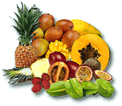
April 2007
The Daley News
As the sting of summer leaves us and we roll into the clear deep blue skies of autumn the orchard is looking wonderful and is providing us with some excellent pickings and treats. We have been harvesting the first of the eagerly 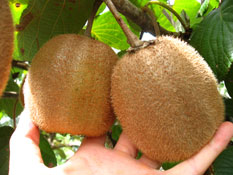 awaited persimmon varieties Izu and 20th Century. There is a bountiful crop of kiwi fruit this year with several different varieties coming off the vines we are spoilt for choice. The H4's are the biggest kiwi's I have ever seen and they have cropped beautifully this year, we have a new selection of the golden kiwi that we have grown from seed and are trialling in the orchard this year. Known as the Sweetie kiwi it cropped well here in Kyogle and appears to be lower chill than the H4 which is exciting. We are hoping to have these in production next season. I have finally had the opportunity to try a hardy kiwi or the coctail kiwi and I must admit I am quite taken by these tiny little fruits. They are the size of a grape with a thin smooth edible skin
awaited persimmon varieties Izu and 20th Century. There is a bountiful crop of kiwi fruit this year with several different varieties coming off the vines we are spoilt for choice. The H4's are the biggest kiwi's I have ever seen and they have cropped beautifully this year, we have a new selection of the golden kiwi that we have grown from seed and are trialling in the orchard this year. Known as the Sweetie kiwi it cropped well here in Kyogle and appears to be lower chill than the H4 which is exciting. We are hoping to have these in production next season. I have finally had the opportunity to try a hardy kiwi or the coctail kiwi and I must admit I am quite taken by these tiny little fruits. They are the size of a grape with a thin smooth edible skin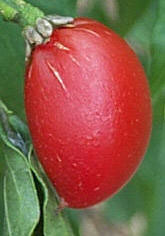 and delicious sweet flesh just like a kiwifruit but bite sized and sweeter. The cherimoyas are just starting to come off the trees as are the peanut butter fruits which are delicious spread on toast for breakfast. We have had a bumper crop of feijoas and have been able to enjoy them this year as never before as our fruit fly controls are paying off. Every week on a Friday Greg sprays the orchard with eco-naturalure, he uses 50ml in 1l of water for about 1/2 hectare of orchard. Every third or fourth tree is sprayed on the underside of it leaves, this protects the product from washing off in the rain. The fruits are not sprayed. We have been doing this since August 2006 and have noticed a marked reduction in the number of flies
and delicious sweet flesh just like a kiwifruit but bite sized and sweeter. The cherimoyas are just starting to come off the trees as are the peanut butter fruits which are delicious spread on toast for breakfast. We have had a bumper crop of feijoas and have been able to enjoy them this year as never before as our fruit fly controls are paying off. Every week on a Friday Greg sprays the orchard with eco-naturalure, he uses 50ml in 1l of water for about 1/2 hectare of orchard. Every third or fourth tree is sprayed on the underside of it leaves, this protects the product from washing off in the rain. The fruits are not sprayed. We have been doing this since August 2006 and have noticed a marked reduction in the number of flies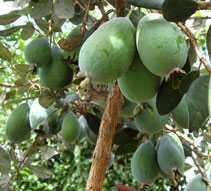 present in the orchard. We enjoyed the stone fruits in the spring and now the guavas and feijoas which are the real test as they are notorious for having fruit fly. I monitor fly numbers with three traps of Wild May that I have in the guavas and a nectarine tree, Wild May attracts the male flies only, I count the number caught so we can see how active the flies are. As fruit flies breed up in the soil under fruit trees it is important to make fruit fly control a regular job in the orchard to reduce the numbers of flies in your area, picking up all fallen fruit helps reduce the population and breaks the breeding cycle of the flies.
present in the orchard. We enjoyed the stone fruits in the spring and now the guavas and feijoas which are the real test as they are notorious for having fruit fly. I monitor fly numbers with three traps of Wild May that I have in the guavas and a nectarine tree, Wild May attracts the male flies only, I count the number caught so we can see how active the flies are. As fruit flies breed up in the soil under fruit trees it is important to make fruit fly control a regular job in the orchard to reduce the numbers of flies in your area, picking up all fallen fruit helps reduce the population and breaks the breeding cycle of the flies.
Panama Berry - Muntingia calabura
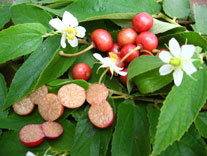 I have a panama berry tree in my home orchard and it is one of my most favourite trees, especially at the moment when it is fruiting. The trees are exceptionally attractive with long spreading branches that often droop down to the ground and soft weeping foliage. Trees are very fast growing and will fruit in their first year. They can grow 5-10m in ideal conditions but respond well to being cut back so it is possible to keep them smaller than this making it easier to browse on the tempting little fruits. Panama berries will happily grow and fruit in large containers provided they have a good quality mix and a healthy layer of organic mulch to hold the moisture in.
I have a panama berry tree in my home orchard and it is one of my most favourite trees, especially at the moment when it is fruiting. The trees are exceptionally attractive with long spreading branches that often droop down to the ground and soft weeping foliage. Trees are very fast growing and will fruit in their first year. They can grow 5-10m in ideal conditions but respond well to being cut back so it is possible to keep them smaller than this making it easier to browse on the tempting little fruits. Panama berries will happily grow and fruit in large containers provided they have a good quality mix and a healthy layer of organic mulch to hold the moisture in.
The small fruits hang hidden under the leaves of the tree, I have found that the birds have not yet discovered the joys of the panama berry at my place. They are about  the size of a small cherry and are very sweet, the tiny fine seeds are edible and give a light texture to the fruit. The flowers and fruits are produced gradually so there is never an over abundance of panama berries, making it a perfect snacking tree. It is the ideal backyard tree if you have children as it is a lovely little shade tree as well as producing tempting little sweet treats.
the size of a small cherry and are very sweet, the tiny fine seeds are edible and give a light texture to the fruit. The flowers and fruits are produced gradually so there is never an over abundance of panama berries, making it a perfect snacking tree. It is the ideal backyard tree if you have children as it is a lovely little shade tree as well as producing tempting little sweet treats.
If your panama berries should ever make it in to your kitchen they can be used to make jams, tarts or added into fruit salads and eaten fresh. In Brazil trees are planted on river banks so that they hang out over the water, their fallen fruit attracts fish which are then caught by the fishermen under the shade of the tree.
Hard Quandong - Elaeocarpus obovatus
The hard quandong is a beautiful rainforest tree that grows from about 10m - 30m. It is seldom seen in cultivation as it is very hard to propagate, however it is a hardy and adaptable tree and is an excellent addition to any rainforest or regeneration plot. Trees are naturally found along water courses and in moist gullies in littoral, dry and low land rainforest north from Sydney. In their natural forest setting trees can reach their maximum height of 30m and have beautiful straight, heavily buttressed pale trunks. Like other members of the family they have dainty fringed flowers that are often produced in profusion every few years, followed by a crop of stunning blue fruits. The flesh around the seed is edible.
Our Daley Visits to Doug Campbell's
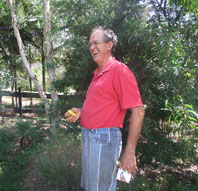 Doug Campbell is a well known local identity in Kyogle whose name is synonymous with chainsaws and axes, but as we have discovered Doug and his wife Pam also have a great passion for rainforest trees and their backyard is bursting with a beautiful rainforest garden. Doug and Pam started their rainforest patch about thirteen years ago with a mass planting centered around their existing mature fig tree, these young trees have now formed a canopy and five years ago Doug and Pam began adding some of the more tropical and cold sensitive species in the shelter of the maturing trees. Doug and Pam have well over one hundred different types of rainforest trees in their garden including many rare, unusual and tropical trees as well as our local species.
Doug Campbell is a well known local identity in Kyogle whose name is synonymous with chainsaws and axes, but as we have discovered Doug and his wife Pam also have a great passion for rainforest trees and their backyard is bursting with a beautiful rainforest garden. Doug and Pam started their rainforest patch about thirteen years ago with a mass planting centered around their existing mature fig tree, these young trees have now formed a canopy and five years ago Doug and Pam began adding some of the more tropical and cold sensitive species in the shelter of the maturing trees. Doug and Pam have well over one hundred different types of rainforest trees in their garden including many rare, unusual and tropical trees as well as our local species. 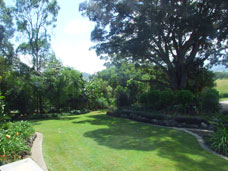 They have happily opened their garden to the Daley's staff and we have made numerous visits to them with our notebooks, seeds bags and secateurs. They have a fine specimen of the Richmond birdwing vine which had lots of orange fruits adorning it; I am hoping that these are happily germinating in my green house to be ready for my hungry caterpillars. The most stunning thing about the garden is its beauty and variety as there is always something in flower or fruit and many of our native rainforest trees are flamboyant by nature with dramatic colours and foliage flushes. As the canopies begin to fill out it is the understory and the epiphytes that they are now working on as another of their passions is orchids and there is lots of vertical space to attach these to the trunks and branches. Native birds love the
They have happily opened their garden to the Daley's staff and we have made numerous visits to them with our notebooks, seeds bags and secateurs. They have a fine specimen of the Richmond birdwing vine which had lots of orange fruits adorning it; I am hoping that these are happily germinating in my green house to be ready for my hungry caterpillars. The most stunning thing about the garden is its beauty and variety as there is always something in flower or fruit and many of our native rainforest trees are flamboyant by nature with dramatic colours and foliage flushes. As the canopies begin to fill out it is the understory and the epiphytes that they are now working on as another of their passions is orchids and there is lots of vertical space to attach these to the trunks and branches. Native birds love the 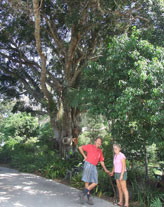 Campbell's developing forest and they have even been visited by a colourful Wompoo fruit dove. Doug and Pam showed us lots of local rainforest trees germinating under their young forest that have been left by visiting birds. There is a wonderful specimen of fingerlime in the garden, it is lush green and about four meters high, the fruits are medium sized and bright yellow with large vesicles of lime juice. A big thank you to Doug and Pam for the numerous tours that they have indulged us all with, it is fantastic to see so many of our beautiful native rainforest trees in a real suburban jungle.
Campbell's developing forest and they have even been visited by a colourful Wompoo fruit dove. Doug and Pam showed us lots of local rainforest trees germinating under their young forest that have been left by visiting birds. There is a wonderful specimen of fingerlime in the garden, it is lush green and about four meters high, the fruits are medium sized and bright yellow with large vesicles of lime juice. A big thank you to Doug and Pam for the numerous tours that they have indulged us all with, it is fantastic to see so many of our beautiful native rainforest trees in a real suburban jungle.





